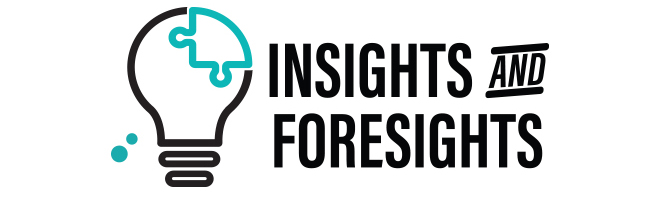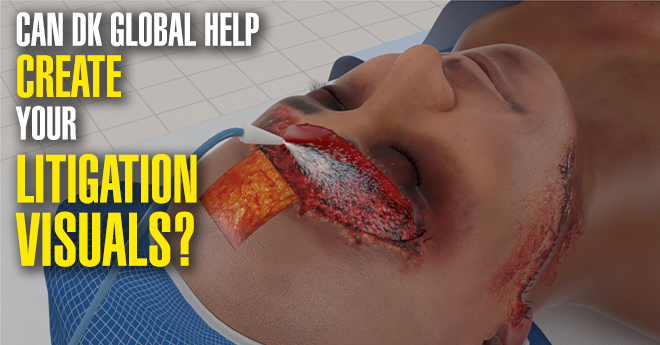Insights & Foresights: The Best Ways to Protect Your Litigation Visuals in Court
Humans process visual information 60,000 times faster than text. In a 2016 NIH study, researchers found that visual demonstratives help audiences understand complex topics easier, maintain attention, and retain accurate information over extended periods. The legal landscape is evolving, making litigation visuals an essential tool to persuade, engage, and communicate.
Alex Deaconson, DK Global’s Senior Visual Consultant, shared his expertise and insight to answer one of the top questions we receive: how can attorneys protect their litigation visuals from inadmissibility? Here are four successful ways attorneys can get the best chances of having their visuals admitted in court.
Number One: Present your Animations and Illustrations as Demonstrative Exhibits
Demonstrative exhibits are not the same as substantive evidence. They are visual illustrations of your expert’s findings and testimony to help viewers grasp a case’s intricate details and/or experts’ testimonies. The likelihood of getting your litigation visuals – like animations and illustrations – admitted in court depends on their probative value outweighing the risk of unfair bias or confusion.
At DK Global, we consider ourselves the “paintbrush” for your expert and witness testimonies. Through this partnership, we bring their findings and experiences to life, paving the way to an authenticated demonstrative.
Number Two: Collaborate with Your Experts from the Beginning
Before admitting your demonstratives to be shown in court, a judge will examine how they were created. Therefore, attorneys and their experts must be prepared to explain that their expertise, guidance, and evidence directed how the visuals were produced.
According to the Daubert standard, a demonstrative is admissible if it is composed of expert analysis and factual evidence. Thus, only expert-backed data and information can be used in an exhibit, confirming the visuals are accurate and relevant. Moreover, including your experts from the beginning of the production process ensures the visual best represents their testimony and the case’s evidence.
Number Three: Use Storyboarding to Create Foundation
Before jumping into the animation process, storyboards build the foundation for your visuals. Storyboards are a series of simplified images or animations that depict the content and camera angles in a demonstrative’s final draft. This process guarantees the case’s important details are presented effectively before becoming more costly to edit during production.
Number Four: Use Real-World Data and Evidence
Evidentiary data is provided by an attorney’s experts. When we create accident reconstructions, for instance, we input information taken from a vehicle’s event data recorder into our animation software to simulate the 3D car’s movement. This ensures the animation’s mechanics are as lifelike as possible, bridging the gap between a simulation and the seriousness of an accident. In addition, some attorneys use cutting-edge tools like point cloud scans and LiDAR to precisely recreate environments and vehicle damage.
Other examples of real-world data that can be used in visual demonstratives include medical scans like X-rays, MRIs, and CT scans. In fact, the scans themselves can be augmented to highlight damages that are hard for lay viewers to spot or understand.
To increase the likelihood of your litigation visuals being admitted in court, they must be relevant, accurate, and authenticated by experts. Using exaggerated imagery, unsupported claims, and incorrect information will make your visuals inadmissible. Today, litigation visuals are no longer a luxury; they are critical to a case’s success. To maximize your settlements and verdicts, or to find out more, speak with a Visual Consultant today.
Humans process visual information 60,000 times faster than text. In a 2016 NIH study, researchers found that visual demonstratives help audiences understand complex topics easier, maintain attention, and retain accurate information over extended periods. The legal landscape is evolving, making litigation visuals an essential tool to persuade, engage, and communicate.
Alex Deaconson, DK Global’s Senior Visual Consultant, shared his expertise and insight to answer one of the top questions we receive: how can attorneys protect their litigation visuals from inadmissibility? Here are four successful ways attorneys can get the best chances of having their visuals admitted in court.
Number One: Present your Animations and Illustrations as Demonstrative Exhibits
Demonstrative exhibits are not the same as substantive evidence. They are visual illustrations of your expert’s findings and testimony to help viewers grasp a case’s intricate details and/or experts’ testimonies. The likelihood of getting your litigation visuals – like animations and illustrations – admitted in court depends on their probative value outweighing the risk of unfair bias or confusion.
At DK Global, we consider ourselves the “paintbrush” for your expert and witness testimonies. Through this partnership, we bring their findings and experiences to life, paving the way to an authenticated demonstrative.
Number Two: Collaborate with Your Experts from the Beginning
Before admitting your demonstratives to be shown in court, a judge will examine how they were created. Therefore, attorneys and their experts must be prepared to explain that their expertise, guidance, and evidence directed how the visuals were produced.
According to the Daubert standard, a demonstrative is admissible if it is composed of expert analysis and factual evidence. Thus, only expert-backed data and information can be used in an exhibit, confirming the visuals are accurate and relevant. Moreover, including your experts from the beginning of the production process ensures the visual best represents their testimony and the case’s evidence.
Number Three: Use Storyboarding to Create Foundation
Before jumping into the animation process, storyboards build the foundation for your visuals. Storyboards are a series of simplified images or animations that depict the content and camera angles in a demonstrative’s final draft. This process guarantees the case’s important details are presented effectively before becoming more costly to edit during production.
Number Four: Use Real-World Data and Evidence
Evidentiary data is provided by an attorney’s experts. When we create accident reconstructions, for instance, we input information taken from a vehicle’s event data recorder into our animation software to simulate the 3D car’s movement. This ensures the animation’s mechanics are as lifelike as possible, bridging the gap between a simulation and the seriousness of an accident. In addition, some attorneys use cutting-edge tools like point cloud scans and LiDAR to precisely recreate environments and vehicle damage.
Other examples of real-world data that can be used in visual demonstratives include medical scans like X-rays, MRIs, and CT scans. In fact, the scans themselves can be augmented to highlight damages that are hard for lay viewers to spot or understand.
To increase the likelihood of your litigation visuals being admitted in court, they must be relevant, accurate, and authenticated by experts. Using exaggerated imagery, unsupported claims, and incorrect information will make your visuals inadmissible. Today, litigation visuals are no longer a luxury; they are critical to a case’s success. To maximize your settlements and verdicts, or to find out more, speak with a Visual Consultant today.
|


